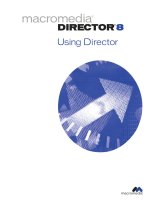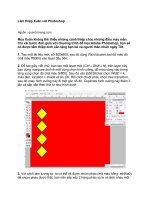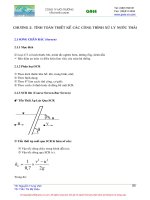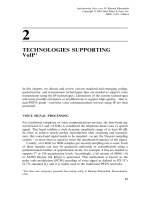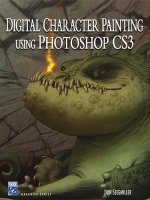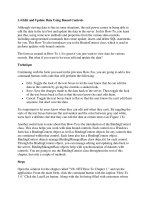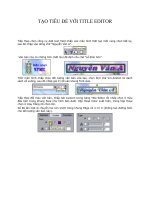Tài liệu Digital Character Painting Using Photoshop CS3 P2 pdf
Bạn đang xem bản rút gọn của tài liệu. Xem và tải ngay bản đầy đủ của tài liệu tại đây (648.89 KB, 10 trang )
This page intentionally left blank
CHAPTER
3
EXPANDING ON YOUR
IDEAS WHEN CREATING
THE CHARACTER
19
20 Digital Character Painting Using Photoshop CS3
T
his chapter is about ideas—where they come from and how to develop the
ones you have. There is no doubt that coming up with creative ideas is tough
work. Nothing grows in a vacuum, and the best ideas and designs do not come
easy. Artists often sit around in their studios or at their desks, virtually a vacuum,
pondering where the next idea will come from. Often we sit and scribble on what-
ever paper is handy, tap the pencil, scribble some more, and then wonder where we
lost our ability to think of good ideas.
Good character designs do not usually come from sitting, tapping a pencil, or jump-
ing directly to the sketching. Planning and preliminary work are always needed and
will pay great dividends in the finished design. This is what this chapter is all about.
Here we present a few strategies to help charge your creative energy. These ideas are
not the only things that you can do, but if you’re stuck, they’ll help get you rolling.
The majority of the exercises and suggestions presented in this chapter are about
generating creative thought. While you need nothing more than your brain to give
these ideas a try, you should probably have a pencil and paper ready in anticipation
of that epiphany.
B
ASIC
S
TRATEGIES TO
H
ELP
G
ENERATE
C
REATIVE
I
DEAS
Coming up with new and creative ideas for a character is, at best, a lot of work. It’s
harder to get inspired design ideas if you simply bounce them around in the confines
of your mind. If possible, get all of your senses involved.
Learning to Relax
The first and most important thing you can do for yourself when you are faced with
a creative problem is to take a deep breath and relax. Talk to yourself a little about
the problem. Take another deep breath and make sure you are feeling calm and con-
fident. The more you can lower your stress and anxiety levels, the better your
chances for mental clarity will be as you begin coming up with ideas.
When you are calm, collected, and ready to start working on some great ideas, use
a combination of the following suggestions to help you come up with creative ideas:
1. Take a walk and clear your mind. We’re not talking a power walk, where
you try to get exercise; we mean a stroll, during which you observe what is
around you and your mind can wander. Daydream. Lie down on a grassy hill
and look at the clouds. See the shapes within them and let the shapes you see
suggest images to you. Sit down on a rock by a stream or river and watch the
water. All of these things will help free your mind.
2. Closely observe the people around you every day. If you do this, you
will begin to notice special qualities that you didn’t see before. As your mind
begins thinking about your basic character idea, consider applying to your
character the individual qualities, traits, physical appearance, quirks, habits,
and faults of your friends. Don’t just limit yourself to friends. Include the
larger circle of your acquaintances as well as celebrities, politicians, sports
Chapter 3 Expanding on Your Ideas When Creating the Character 21
stars, and anyone in the public eye. If you are designing a villain, why not
base the character on people that you just do not like? You can also look at
fictional characters, but watching them is not as much fun as observing real
people. Remember that a fictional character is already someone else’s vision
and as such is nothing more than a shallow representation of a personality,
whereas real people have much more depth.
3. Have a brainstorming session with a few other people. Brainstorming
by yourself is never successful, but brainstorm with four or five people and
see what happens. As an example of how well this works, try to think of 50
new and unique ways to use a brick. If you did this exercise alone, you
probably couldn’t come up with 50 variations, but if you get four or five cre-
ative people together in a room, they will likely come up with some very
creative ideas. Of course, many of the ideas will not be usable. Usability is
not the point, and it does not matter if some of the ideas are outrageous. The
point is to begin looking at the subject in a new light. Figure 3.1 shows what
it can sometimes feel like when you have to come up with new ideas.
FIGURE 3.1 Brainstorming can be painful but rewarding.
22 Digital Character Painting Using Photoshop CS3
Locating Useful Reference Materials
Being able to find appropriate reference materials and learning how to use them is one
of the most important abilities an artist can have. In fact, one of the most important
skills you can acquire is knowing how to find information that will be useful and in-
spiring to you as you design your character. Learn how to use the local library. Learn
how to use the Internet to find visually inspiring imagery; you can find anything on
the Internet these days. The vast amount of visual and written information on the Web
can be overwhelming if you are not careful, so make sure to spend your time effectively.
Using Wordplay
Playing with words can be one of the best ways to come up with good ideas. Basi-
cally, this exercise consists of writing columns of words and combining them in un-
usual ways. You can literally draw lines from one word to another. Combinations
you never thought of will arise. If needed, take some time to create lists that are spe-
cific to the project you are working on. It would not do much good to list ocean
creatures if you were working on a space character.
Here is an example of a very short list to illustrate the concept of combining words
to form new ideas to work with. Of course, this list is not meant for any specific prob-
lem; the lists that you would use should be customized to your problem. Some combi-
nations work better than others. A “sharp heroic” does not make much sense.
1. Knight
2. Obtuse
3. Shiny
4. Vicious
5. Mermaid
6. Heroic
7. King
8. Warthog
9. Sharp
10. Friendly
11. Monster
12. Ostrich
Fantasizing About the Character
Fantasize about the character that you need to design. Fantasizing goes hand in hand
with both brainstorming and daydreaming. Fantasizing is more an individual activity
where you would imagine “what if”-type situations about your character, whereas
Chapter 3 Expanding on Your Ideas When Creating the Character 23
brainstorming is best in a group setting, as we have seen. When fantasizing, you will
want to get out of the everyday modes of thought and see how far out you can take
your ideas. “What if?” is the biggest question to ask yourself when you fantasize.
Using Symbolism with the Character
Give the character personality or traits that have symbolic elements. Many symbolic
elements are very easy to relate to. If you use appropriate symbols, your audience
will get quick clues to a character’s personality. For example, if a halo is put over a
character’s head, assumptions can be made, whether right or wrong, about the char-
acter. The symbolism may be public and easily recognized by many people, or it may
be private and have meaning only to you, the creator. Many books that list different
symbols and their meanings are available. Some symbols are timeless, while others
are more contemporary. Examples of some things with symbolic meaning are white
doves, bats, black cats, gold, lead, the planets, and astrological symbols.
Building the Character Around a Myth
Build your character around a myth, or create a myth around your character.
Mythologize your character. The human race has so many different myths and leg-
ends that it’s easy—and to a degree smart—to use them as a basis for your characters
because a mythical character’s history is already so well defined. The character Drac-
ula has become such a strong cultural symbol of the myth that designing a “new”
Dracula would take a lot of work to break the visual mold.
Snowballing
Just as a snowball gains size and speed as it rolls down a hill, snowballing an idea can
help it gain momentum and size. Snowballing is simply adding more and more
wacky notions to a developing idea. Use snowballing in conjunction with brain-
storming, fantasy, wordplay, or just about any other idea-creating exercise.
Visiting Special Places for Inspiration
Visit the zoo. Some of the best ideas can come when you watch the animals as well
as the people. Figure 3.2 shows an unusual character based on someone seen at the
zoo. Along these same lines, go and spend the day at the local airport with a sketch-
book. You will be amazed by the amount of inspiration that walks by.
D
EVELOPING
Y
OUR
B
ASIC
I
DEA
Getting the basic idea of a character is always the hardest part of the creative
process. By doing the simple things we discussed in the last section and not just sit-
ting at your desk in the dark trying to be inspired, you will open up new avenues of
experience that can lead to new ideas for your characters. However, the basic idea is
only the first step. You now have a vision, but it is only a somewhat ghostlike visage
on the edge of your conscience. Your basic idea is floating around either in your
mind or on paper. You know where you want to go with this idea, but you’re feel-
ing somewhat lost as to a direction.
The strategies in the previous section are mostly cerebral, whereas the methods
discussed here are best done visually with a piece of paper and pencil. Not only will
you have a record of idea changes, but your drawings will also help generate addi-
tional ideas. Use relatively inexpensive paper and a soft pencil, marker, or pen.
Do not erase! This is very important. You are not drawing pretty pictures but
generating differing ideas. An eraser will slow you down and kill the creative flow.
No one else is meant to see the images you will create; they are just your thought
processes and ideas coming to life. Don’t expect them to look solid and refined at
this point.
24 Digital Character Painting Using Photoshop CS3
FIGURE 3.2 An interesting character seen at the local zoo.
Chapter 3 Expanding on Your Ideas When Creating the Character 25
The following are some strategies to help you develop a basic but vague idea into
a more concrete visual image ready to be drawn or sketched. They are not the only
ways to firm up an idea but are good methods for continuing the process. As noted
in the previous section, use these ideas in conjunction with each other.
Using Caricature
You can caricature just about anything you are drawing: people, animals, plants,
and maybe even rocks. Caricature can be used to further develop ideas that seem to
have gone stale. Quite often, caricature, while humorous, is looking for the essence
of the subject. If you are having trouble seeing where to go with a design, try doing
a caricature of what you already have. Once you have again found the essence of
the caricature, continue with the design. Figure 3.3 shows an example of caricature.
FIGURE 3.3 A caricature of a family dog.
Using Humor
Humor is a great way to take an idea that is stalled and jump-start the creative
process. Humor’s main purpose is to entertain, and it generally does not need a lot
of explanation. Humor does not try to make a statement. For example, if you are de-
veloping a serious barbarian character, put him in a humorous situation or change
his props to something humorous (as in Figure 3.4) and see how many more cre-
ative vistas open for you.
26 Digital Character Painting Using Photoshop CS3
Using Blotter Pictures
So you are still stuck. You still need to design new and exciting characters and even
costumes for them. Perhaps you should try using some blotter pictures to get some
ideas brewing. Blotter pictures are the same thing as the famous Rorschach psycholog-
ical test and are extremely easy to do on the computer. Figure 3.5 shows an example
of a blotter picture.
FIGURE 3.4 A gladiator armed only with asparagus and a smile.
FIGURE 3.5 A computer-generated inkblot.
Chapter 3 Expanding on Your Ideas When Creating the Character 27
Black and white as well as color work well. Black and white usually works bet-
ter when you are trying to come up with ideas for form shapes (Figure 3.6), whereas
color tends to work better for ideas that are decorative in nature (Figure 3.7).
FIGURE 3.6 A black-and-white inkblot picture.
FIGURE 3.7 A color inkblot picture.
Using Exaggeration
Exaggeration, which is an integral part of caricature, is fairly self-explanatory. Take
your character idea and exaggerate some portion of it. The exaggeration can either be
extreme or subtle, depending on your intention. Be careful that you do not exagger-
ate everything within the character. After all, exaggeration is based on the difference
